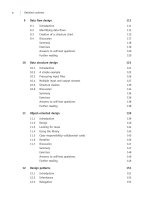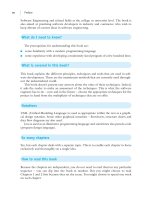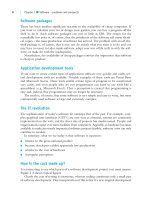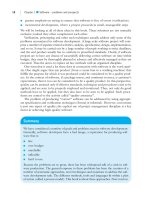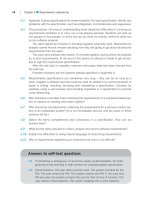Software Engineering For Students: A Programming Approach Part 3 docx
Bạn đang xem bản rút gọn của tài liệu. Xem và tải ngay bản đầy đủ của tài liệu tại đây (126.53 KB, 10 trang )
Software Engineering and related fields at the college or university level. The book is
also aimed at practising software developers in industry and commerce who wish to
keep abreast of current ideas in software engineering.
The prerequisites for understanding this book are:
■ some familiarity with a modern programming language
■ some experience with developing a moderately sized program of a few hundred lines.
This book explains the different principles, techniques and tools that are used in soft-
ware development. These are the mainstream methods that are currently used through-
out the industrialized world.
This book doesn’t present easy answers about the value of these techniques. Indeed,
it asks the reader to make an assessment of the techniques. This is what the software
engineer has to do – now and in the future – choose the appropriate techniques for the
project in hand from the multiplicity of techniques that are on offer.
UML (Unified Modeling Language) is used as appropriate within the text as a graphi-
cal design notation. Some other graphical notations – flowcharts, structure charts and
data flow diagrams are also used.
Java is used as an illustrative programming language and sometimes also pseudo code
(program design language).
Yes, but each chapter deals with a separate topic. This is to enable each chapter to focus
exclusively and thoroughly on a single idea.
Because the chapters are independent, you do not need to read them in any particular
sequence – you can dip into the book at random. But you might choose to read
Chapters 1 and 2 first because they set the scene. You might choose to spend one week
on each chapter.
How to read this book
So many chapters
Notations
xx Preface
What do I need to know?
What is covered in this book?
BELL_A01.QXD 2/2/05 3:20 PM Page xx
Preface xxi
The chapters are grouped into sections on:
■ preliminaries
■ design
■ programming languages
■ verification
■ process models
■ project management
■ review.
Several of these sections present a variety of alternative techniques, for example, a vari-
ety of design approaches.
A number of case studies are used throughout the book to illustrate the use of the var-
ious techniques. They constitute a range of typical software systems and are presented
in Appendix A. Many chapters use one of the case studies. The case studies are also used
as part of the exercises at the end of each chapter.
You could also use the case studies as projects carried out in parallel to the study of
this book.
These are placed throughout the text so that you can check your understanding of top-
ics. They promote active learning. The answers are at the end of each chapter.
With the notable exception of four chapters on languages, we do not have a separate
chapter on software tools. Instead we ask the reader in the exercises to suggest suitable
tools for use with each technique.
This book is about the theories behind software engineering and gives an explanation
of current techniques. But many people would argue you really need to experience the
reality of software development to fully appreciate the ideas. Probably, therefore, you
Is this all I need to know?
Software tools
Self-test questions
Case studies
The organization of this book
BELL_A01.QXD 2/2/05 3:20 PM Page xxi
are engaged on a project of some size while you study this book. Good luck with your
practical project. (The case studies in Appendix A may serve as projects.)
Visit the website associated with the book to see additional material and any updates at
www.pearsoned.co.uk/bell.
Special thanks to my closest collaborator on this book, Alice Bell, particularly for writing
Chapter 25. Many thanks to current and past colleagues, including (in alphabetical order)
Babak Akhgar, Chris Bates, Andy Bissett, Pete Collingwood, Gordon Doole, Chuck
Elliot, Jan Graba, Chris Hall, Babak Khazaei, Mehdi Mir, Ian Morrey, Mehmet Ozcan,
Mike Parr, John Pugh, Chris Roast, Dharmendra Shadija, Jawed Siddiqi. All misconcep-
tions are, of course, the author’s.
Acknowledgments
Website
xxii Preface
BELL_A01.QXD 2/2/05 3:20 PM Page xxii
PART
A
PRELIMINARIES
BELL_CPARTA.QXD 1/30/05 4:29 PM Page 1
BELL_CPARTA.QXD 1/30/05 4:29 PM Page 2
Software Engineering is about methods, tools and techniques used for developing soft-
ware. This particular chapter is concerned with the reasons for having a field of study
called software engineering, and with the problems that are encountered in developing
software. This book as a whole explains a variety of techniques that attempt to solve the
problems and meet the goals of software engineering.
Software surrounds us everywhere in the industrialized nations – in domestic appli-
ances, communications systems, transportation systems and in businesses. Software comes
in different shapes and sizes – from the program in a mobile phone to the software to
design a new automobile. In categorizing software, we can distinguish two major types:
■ system software is the software that acts as tools to help construct or support appli-
cations software. Examples are operating systems, databases, networking software,
compilers.
■ applications software is software that helps perform some directly useful or enjoyable
task. Examples are games, the software for automatic teller machines (ATMs), the
control software in an airplane, e-mail software, word processors, spreadsheets.
Within the category of applications software, it can be useful to identify the following
categories of software:
■ games
■ information systems – systems that store and access large amounts of data, for ex-
ample, an airline seat reservation system
1.1
●
Introduction
CHAPTER
1
Software – problems
and prospects
This chapter:
■ reviews the goals of software engineering
■ describes the difficulties of constructing large-scale software
■ analyses the problems that software engineers face.
BELL_C01.QXD 1/30/05 4:13 PM Page 3
4 Chapter 1 ■ Software – problems and prospects
■ real-time systems – in which the computer must respond quickly, for example, the
control software for a power station
■ embedded systems – in which the computer plays a smallish role within a larger sys-
tem, for example, the software in a telephone exchange or a mobile phone.
Embedded systems are usually also real-time systems
■ office software – word processors, spreadsheets, e-mail
■ scientific software – carrying out calculations, modeling, prediction, for example,
weather forecasting.
Software can either be off-the-shelf (e.g. Microsoft Word) or tailor-made for a particu-
lar application (e.g. software for the Apollo moon shots). The latter is sometimes called
bespoke software.
All these types of software – except perhaps information systems – fall within the
remit of software engineering. Information systems have a different history and, gener-
ally, different techniques are used for their development. Often the nature of the data
(information) is used to dictate the structure of the software, so that analysis of the data
is a prime step, leading to the design of the database for the application. This approach
to software development is outside the scope of this book.
Constructing software is a challenging task, essentially because software is complex.
The perceived problems in software development and the goals that software develop-
ment seeks to achieve are:
■ meeting users’ needs
■ low cost of production
■ high performance
■ portability
■ low cost of maintenance
■ high reliability
■ delivery on time.
Each goal is also considered to be a problem because software engineering has gener-
ally been rather unsuccessful at reaching them. We will now look at each of these goals
in turn. Later we will look at how the goals relate one to another.
In the remainder of this book we shall see that the development of particular types
of software requires the use of special techniques, but many development techniques
have general applicability.
It seems an obvious remark to make that a piece of software must do what its users want
of it. Thus, logically, the first step in developing some software is to find out what the
client, customer or user needs. This step is often called requirements analysis or require-
ments engineering. It also seems obvious that it should be carried out with some care.
1.2
●
Meeting users’ needs
BELL_C01.QXD 1/30/05 4:13 PM Page 4
1.3 The cost of software production 5
There is evidence, however, that this is not always the case. As evidence, one study of
the effectiveness of large-scale software projects, Figure 1.1, found that less than 2%
were used as delivered.
These figures are one of the few pieces of hard evidence available, because (not sur-
prisingly) organizations are rather secretive about this issue. Whatever the exact fig-
ures, it seems that a large proportion of systems do not meet the needs of their users
and are therefore not used as supplied. It may be, of course, that smaller systems are
more successful.
We might go further and deduce that the main problem of software development
lies in requirements analysis rather than in any other areas, such as reliability or cost,
which are discussed below.
The task of trying to ensure that software does what its users want is known as
validation.
Examples of costs
First of all, let us get some idea of the scale of software costs in the world. In the USA
it is estimated that about $500 billion are spent each year on producing software. This
amounts to 1% of the gross national product. The estimated figure for the world is that
$1,000 billion is spent each year on software production. These figures are set to rise
by about 15% each year. The operating system that IBM developed for one of its major
range of computers (called OS 360) is estimated to have cost $200 million. In the
USA, the software costs of the manned space program were $1 billion between 1960
and 1970.
These examples indicate that the amount spent on software in the industrialized
nations is of significant proportions.
1.3
●
The cost of software production
Delivered but
not used 47%
Abandoned
or reworked 19%
Paid for but
not delivered 29%
Were used
after change 3%
Used as delivered 2%
Figure 1.1 Effectiveness of typical large software projects
BELL_C01.QXD 1/30/05 4:13 PM Page 5
6 Chapter 1 ■ Software – problems and prospects
Programmer productivity
The cost of software is determined largely by the productivity of the programmers and
the salaries that they are paid. Perhaps surprisingly, the productivity of the average pro-
grammer is only about 10–20 programming language statements per day. To the layper-
son, a productivity of 20 lines of code per day may well seem disgraceful. However, this
is an average figure that should be qualified in two ways. First, enormous differences
between individual programmers – factors of 20 – have been found in studies. Second, the
software type makes a difference: applications software can be written more quickly than
systems software. Also, this apparently poor performance does not just reflect the time
taken to carry out coding, but also includes the time required to carry out clarifying the
problem specification, software design, coding, testing and documentation. Therefore,
the software engineer is involved in many more tasks than just coding. However, what
is interesting is that the above figure for productivity is independent of the programming
language used – it is similar whether a low-level language is used or a high-level language
is used. It is therefore more difficult than it initially appears to attribute the level of pro-
ductivity to laziness, poor tools or inadequate methods.
SELF-TEST QUESTION
1.1 A well-known word processor consists of a million lines of code.
Calculate how many programmers would be needed to write it, assum-
ing that it has to be completed in five years. Assuming that they are each
paid $50,000 per year, what is the cost of development?
Predicting software costs
It is very difficult to predict in advance how long it will take to write a particular piece
of software. It is not uncommon to underestimate the required effort by 50%, and
hence the cost and delivery date of software is also affected.
Hardware versus software costs
The relative costs of hardware and software can be a lively battleground for contro-
versy. In the early days of computers, hardware was costly and software relatively cheap.
Nowadays, thanks to mass production and miniaturization, hardware is cheap and soft-
ware (labor intensive) is expensive. So the costs of hardware and software have been
reversed. These changes are reflected in the so-called “S-shaped curve”, Figure 1.2,
showing the relative costs as they have changed over the years. Whereas, in about 1955,
software cost typically only about 10% of a project, it has now escalated to 90%, with
the hardware comprising only 10%. These proportions should be treated carefully.
They hold for certain projects only and not in each and every case. In fact, figures of
this kind are derived largely from one-off large-scale projects.
BELL_C01.QXD 1/30/05 4:13 PM Page 6
1.3 The cost of software production 7
We will now look at a number of issues that affect the popular perception of soft-
ware and its costs.
The impact of personal computers
Perhaps the greatest influence on popular perceptions of software costs has come about
with the advent of personal computing. Many people buy a PC for their home, and so
come to realize very clearly what the costs are.
First is the “rock and roll” factor. If you buy a stereo for $200, you don’t expect to
pay $2,000 for a CD. Similarly, if you buy a PC for $1,000, you don’t expect to pay
$10,000 for the software, which is what it would cost if you hired a programmer to
write it for you. So, of course, software for a PC either comes free or is priced at about
$50 or so. It can be hard to comprehend that something for which you paid $50 has
cost millions of dollars to develop.
Second is the teenager syndrome. Many school students write programs as part of
their studies. So a parent might easily think, “My kid writes computer programs. What’s
so hard about programming? Why is software so expensive?”
SELF-TEST QUESTION
1.2 Someone buys a PC, with processor, monitor, hard disk and printer.
They also buy an operating system and a word processing package.
Calculate the relative costs of hardware and software.
100%
10%
Hardware
Software
2000
199019801970
Year
Figure 1.2 Changes in the relative costs of hardware and software
BELL_C01.QXD 1/30/05 4:13 PM Page 7


